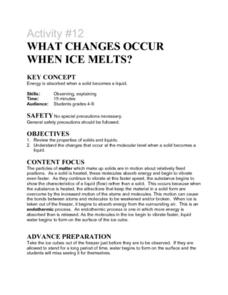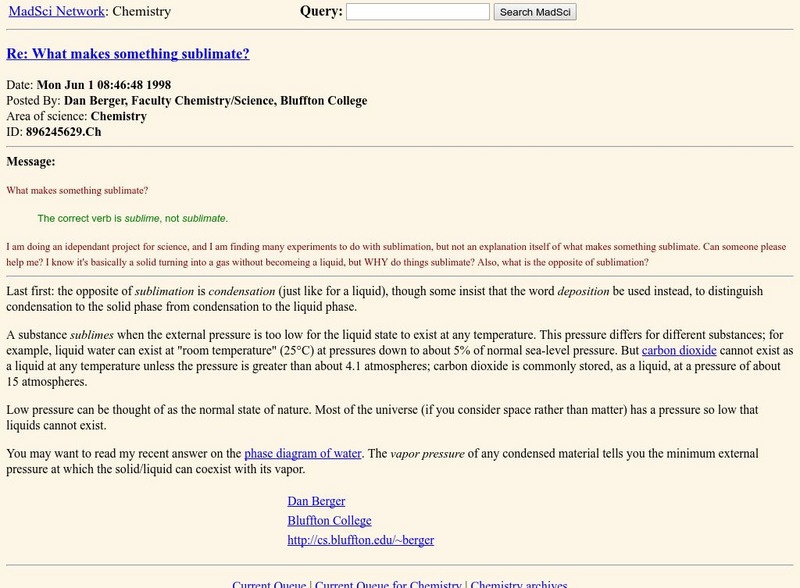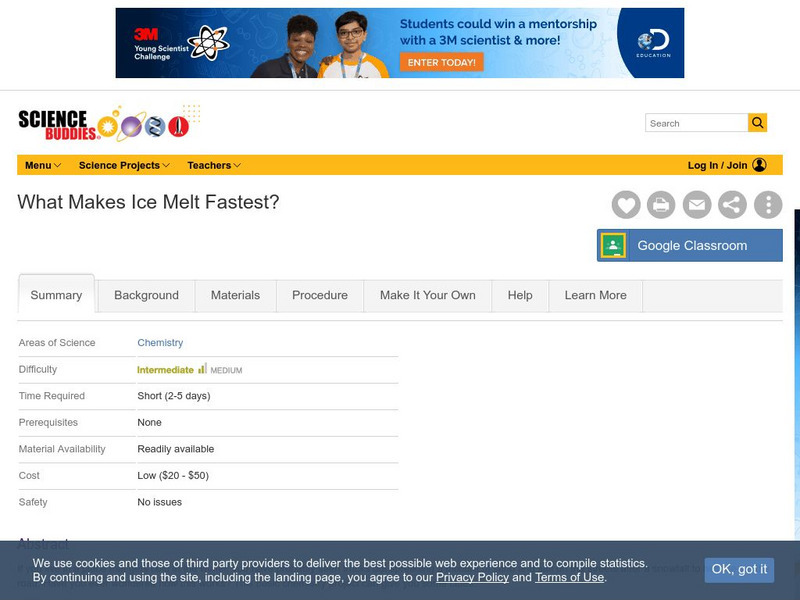Curated OER
Pressure Versus Force: Landing On Ice!
High schoolers experiment with the relationship between pressure, force, and area. They determine the force and pressure exerted by a LC-130, which is commonly used for cargo and personnel transport in Antarctica.
Curated OER
Jeannette
Middle schoolers develop hypothesis about what might happen when salt water is frozen. In groups, they freeze ice samples with different salt concentrations. They use the internet to research the situation of the Jeannette to discover...
Curated OER
FRAM: The Most Famous Ship in the World
Seventh graders role play the roles of naval engineer apprentices. In groups, they work together to design a ship which cannot be damaged by freezing ice. They use the internet to research the weather and ocean conditions of the water...
Curated OER
What's Under There?
Students determine ways to make "observations" about unknowns, such as the land beneath an ice sheet or the interior of the Earth, using tools other than sight. They build "mystery boxes" and exchange them with other groups to "map"...
Curated OER
Snow on Sea Ice
High schoolers examine different samples of ice and predict the amount of snow that has fallen in a given year. Using a calculator, they graph the various thicknesses. They analyze the graphs to determine the relationship between the...
Curated OER
What Changes Occur When Ice Melts?
Students explore the physical process of melting. They observe melting ice and answer questions related to energy transfer during phase changes.
Curated OER
Buried in Ice: The Mystery of a Lost Arctic Expedition
Pupils read a novel about a lost arctic expedition by Sir John Franklin. In groups, they discuss the author's quest to determine what happened to Franklin and his crew. Using the internet, they compare and contrast the expeditions by...
Curated OER
Let's Get To the Core!
Students practice analyzing ice core samples to discover climate changes. Using the samples, they identify and graph the gas amounts. They use these numbers to determine their effect on global warming. In pairs, they complete a...
Curated OER
Physical Properties of Ice
Students explore the different properties of ice. They make predictions and experment with ice. Students discover that ice melts faster under pressure. Students create a flipbook what what happened after each experiment. This...
Curated OER
Icebergs Ahead!
Students experiment with density of ice, and examine how density affects how icebergs float in water.
Curated OER
Sustaining Life Under the Ice
Students design and conduct experiments in order to identify the components of lake water environments that are affected by winter ice cover. They use the experiment results to propose effective human management of these ecosystems.
MadSci Network
The Mad Scientist Network: Chemistry
The question: "What makes something sublimate?" is discussed and explained. Project ideas pertaining to sublimation are suggested.
American Chemical Society
Middle School Chemistry: Changing State: Freezing
Students investigate how low temperature causes water vapor to condense into a liquid and then freeze to form a solid.
American Chemical Society
Middle School Chemistry: Changing State: Melting
Discover the concept that energy transfer and molecular motion cause the change in state from a solid to a liquid. Also compare state changes of water to the state changes of other substances.
NASA
Nasa Earth Observatory: Polar Ice Fact Sheet
Learn about polar ice, its effects on energy exchanges, how much surface area it covers, and how it is affected by global warming.
Science Buddies
Science Buddies: What Makes Ice Melt Fastest?
If you live in a place that gets cold in the winter, you have most likely seen trucks spreading a mixture of sand and salt on the streets after a snowfall to help de-ice roads. This basic chemistry project gives you clues to discover how...
The White House
The White House: Drug Facts: Methamphetamine
This resource provides both general information and statistics about methamphetamine use and the complications associated this dangerous drug. Providing charts, references, and links, this website is a good starting point for those...
Other
Nfia's Guide to Drugs and the Brain
This site provides a list of links to information on different types of drugs. Content on the pages include information about the drug itself, effects the drug has on the brain, common street names for the drug, and legal status.
Other
Methamphetamine: Frequently Asked Questions
Organized into question/answer format, this website on methamphetamine abuse provides information on how this drug affects the body and how the drug is made and obtained. Learn about the health hazards associated with methamphetamine use...
Other
Math and Science Activity Center: Hydrogen Bonds
A site showing the structures of water and ice and explaining how they are affected by hydrogen bonds. Includes a movie animating hydrogen bond formation and disruption.
Other
Simple Science: Snow and Ice I
The innovative resource compares snow and ice cover in the Northern Hemisphere over a period of two years. The activity has an interactive online version and a printable data sheet.
Other
Simple Science: Snow and Ice Ii
The innovative resource compares snow and ice cover in the Northern Hemisphere over a period of 24 years. The images are obtained from satellite measurements of visible and microwave radiation. The activity has an interactive online...
Other
Lunar and Planetary Institute: Explore! Ice Worlds
Features a collection of hands-on activities, investigations, and explorations designed to engage students in learning about ice, both in the solar system and on planet Earth.
NASA
Nasa: The Space Place: Looking for Water Everywhere!
NASA has discovered water in space. This interactive resource allows you to examine the different planets and moons in our solar system to find out where their water is located.




















